A Report on Automated Warehousing in the Australian Paper Industry
VerifiedAdded on 2021/06/17
|12
|3770
|164
Report
AI Summary
This progress report examines the transition of the Australian paper industry's warehousing system from a labor-intensive model to an automated one, grounded in engineering management principles. The report explores the current state of the paper industry in Australia, highlighting the need for automation to enhance efficiency and productivity. It discusses the implementation of robotics and automated systems within warehouses, emphasizing the benefits of reducing labor costs and improving product distribution. The report reviews relevant management concepts such as customer-based innovation, business model innovation, and high-speed innovation, and details the methodologies used, including primary and secondary data collection, and analysis techniques to support the findings. The project underscores the potential for significant economic and operational changes through automation, offering a comprehensive overview of the challenges and opportunities in modernizing paper industry warehousing.
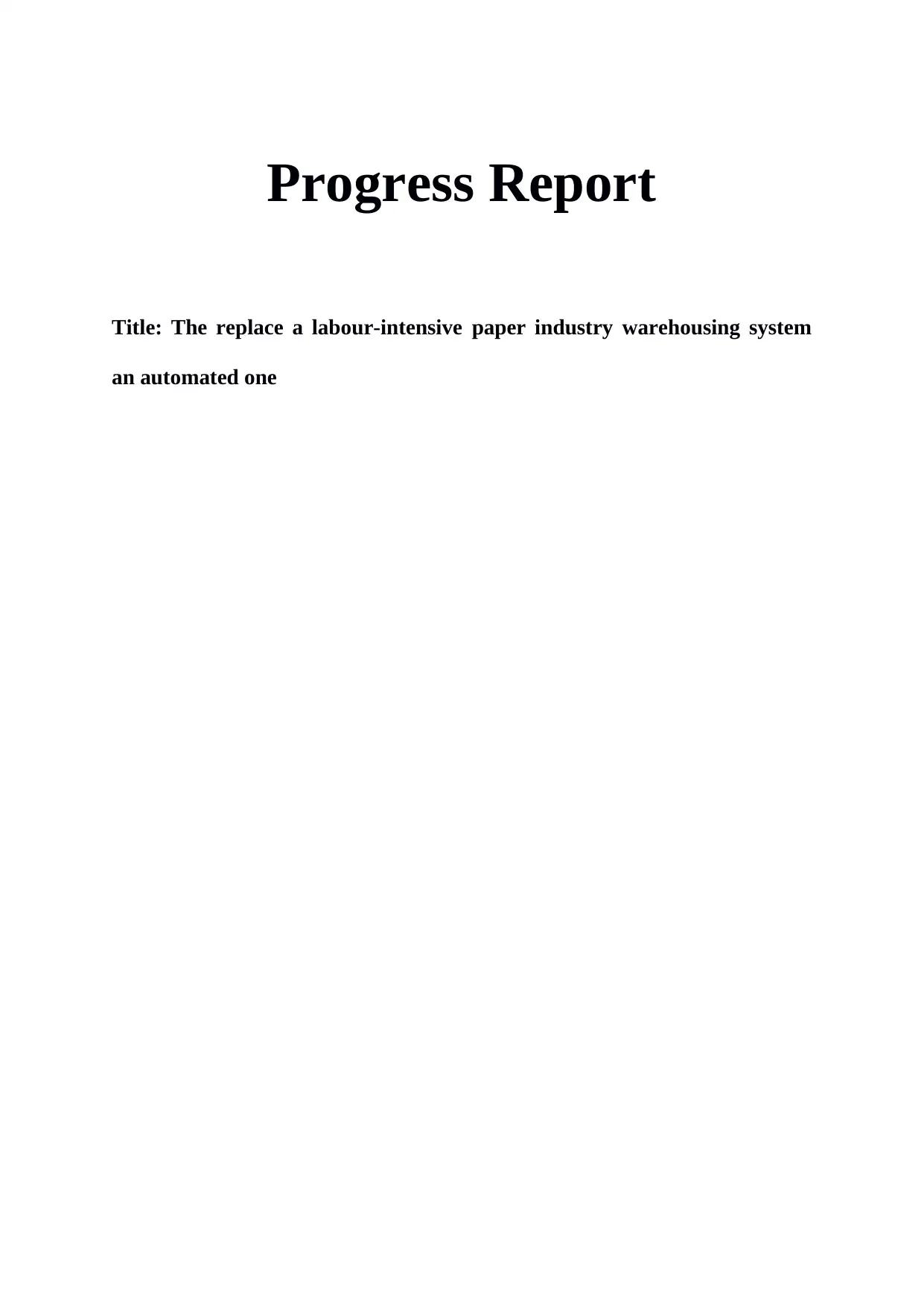
Progress Report
Title: The replace a labour-intensive paper industry warehousing system
an automated one
Title: The replace a labour-intensive paper industry warehousing system
an automated one
Paraphrase This Document
Need a fresh take? Get an instant paraphrase of this document with our AI Paraphraser
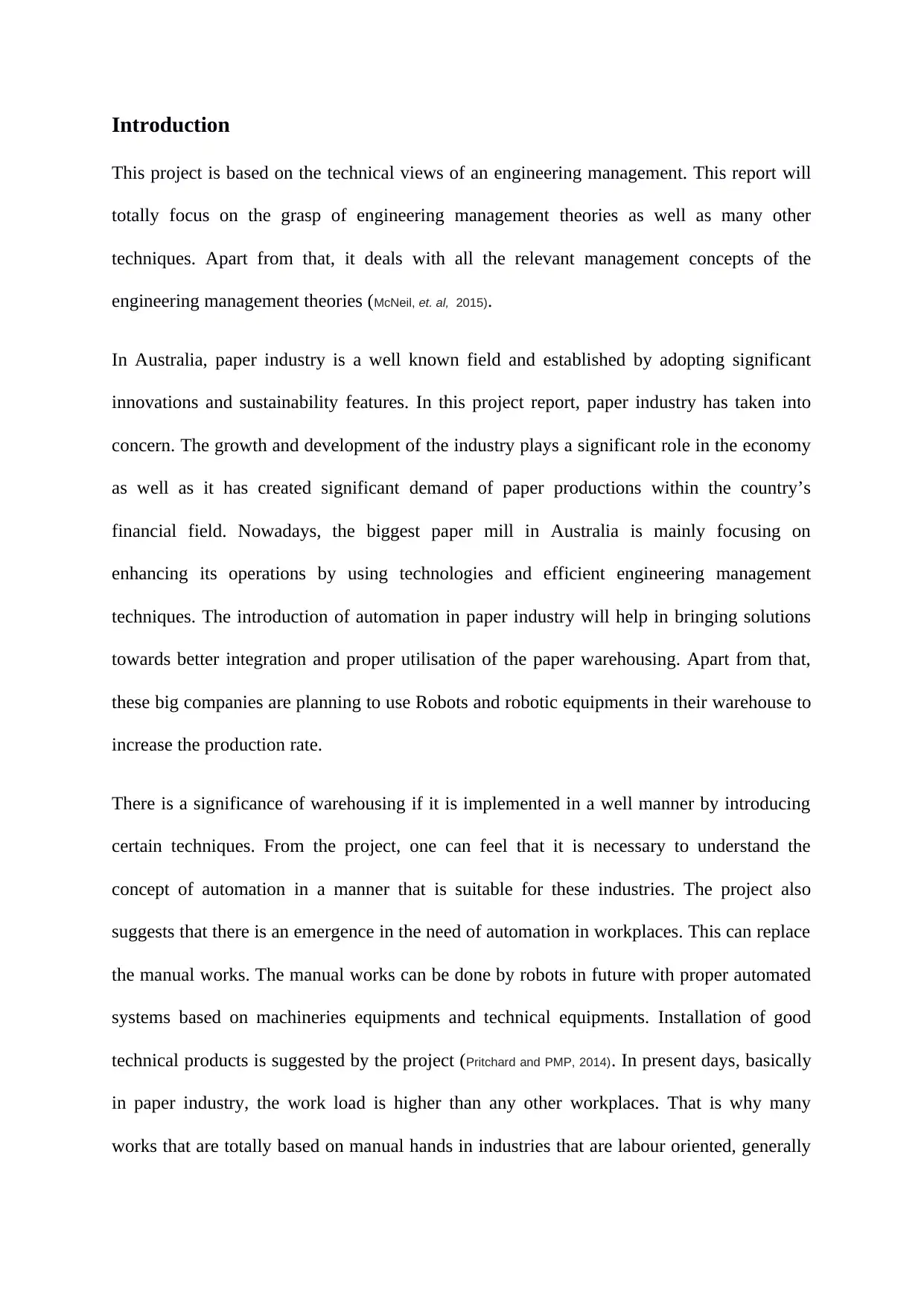
Introduction
This project is based on the technical views of an engineering management. This report will
totally focus on the grasp of engineering management theories as well as many other
techniques. Apart from that, it deals with all the relevant management concepts of the
engineering management theories (McNeil, et. al, 2015).
In Australia, paper industry is a well known field and established by adopting significant
innovations and sustainability features. In this project report, paper industry has taken into
concern. The growth and development of the industry plays a significant role in the economy
as well as it has created significant demand of paper productions within the country’s
financial field. Nowadays, the biggest paper mill in Australia is mainly focusing on
enhancing its operations by using technologies and efficient engineering management
techniques. The introduction of automation in paper industry will help in bringing solutions
towards better integration and proper utilisation of the paper warehousing. Apart from that,
these big companies are planning to use Robots and robotic equipments in their warehouse to
increase the production rate.
There is a significance of warehousing if it is implemented in a well manner by introducing
certain techniques. From the project, one can feel that it is necessary to understand the
concept of automation in a manner that is suitable for these industries. The project also
suggests that there is an emergence in the need of automation in workplaces. This can replace
the manual works. The manual works can be done by robots in future with proper automated
systems based on machineries equipments and technical equipments. Installation of good
technical products is suggested by the project (Pritchard and PMP, 2014). In present days, basically
in paper industry, the work load is higher than any other workplaces. That is why many
works that are totally based on manual hands in industries that are labour oriented, generally
This project is based on the technical views of an engineering management. This report will
totally focus on the grasp of engineering management theories as well as many other
techniques. Apart from that, it deals with all the relevant management concepts of the
engineering management theories (McNeil, et. al, 2015).
In Australia, paper industry is a well known field and established by adopting significant
innovations and sustainability features. In this project report, paper industry has taken into
concern. The growth and development of the industry plays a significant role in the economy
as well as it has created significant demand of paper productions within the country’s
financial field. Nowadays, the biggest paper mill in Australia is mainly focusing on
enhancing its operations by using technologies and efficient engineering management
techniques. The introduction of automation in paper industry will help in bringing solutions
towards better integration and proper utilisation of the paper warehousing. Apart from that,
these big companies are planning to use Robots and robotic equipments in their warehouse to
increase the production rate.
There is a significance of warehousing if it is implemented in a well manner by introducing
certain techniques. From the project, one can feel that it is necessary to understand the
concept of automation in a manner that is suitable for these industries. The project also
suggests that there is an emergence in the need of automation in workplaces. This can replace
the manual works. The manual works can be done by robots in future with proper automated
systems based on machineries equipments and technical equipments. Installation of good
technical products is suggested by the project (Pritchard and PMP, 2014). In present days, basically
in paper industry, the work load is higher than any other workplaces. That is why many
works that are totally based on manual hands in industries that are labour oriented, generally
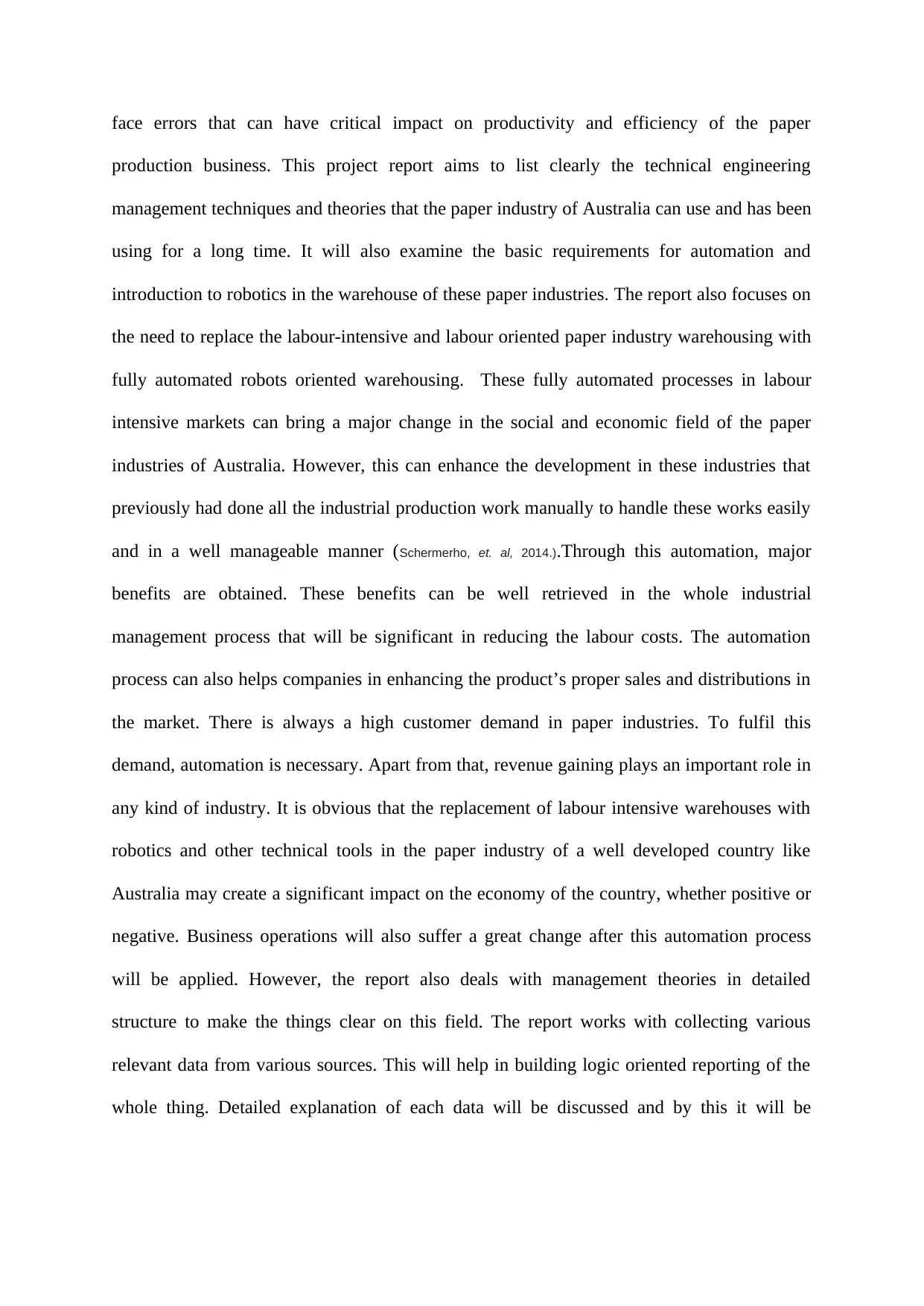
face errors that can have critical impact on productivity and efficiency of the paper
production business. This project report aims to list clearly the technical engineering
management techniques and theories that the paper industry of Australia can use and has been
using for a long time. It will also examine the basic requirements for automation and
introduction to robotics in the warehouse of these paper industries. The report also focuses on
the need to replace the labour-intensive and labour oriented paper industry warehousing with
fully automated robots oriented warehousing. These fully automated processes in labour
intensive markets can bring a major change in the social and economic field of the paper
industries of Australia. However, this can enhance the development in these industries that
previously had done all the industrial production work manually to handle these works easily
and in a well manageable manner (Schermerho, et. al, 2014.).Through this automation, major
benefits are obtained. These benefits can be well retrieved in the whole industrial
management process that will be significant in reducing the labour costs. The automation
process can also helps companies in enhancing the product’s proper sales and distributions in
the market. There is always a high customer demand in paper industries. To fulfil this
demand, automation is necessary. Apart from that, revenue gaining plays an important role in
any kind of industry. It is obvious that the replacement of labour intensive warehouses with
robotics and other technical tools in the paper industry of a well developed country like
Australia may create a significant impact on the economy of the country, whether positive or
negative. Business operations will also suffer a great change after this automation process
will be applied. However, the report also deals with management theories in detailed
structure to make the things clear on this field. The report works with collecting various
relevant data from various sources. This will help in building logic oriented reporting of the
whole thing. Detailed explanation of each data will be discussed and by this it will be
production business. This project report aims to list clearly the technical engineering
management techniques and theories that the paper industry of Australia can use and has been
using for a long time. It will also examine the basic requirements for automation and
introduction to robotics in the warehouse of these paper industries. The report also focuses on
the need to replace the labour-intensive and labour oriented paper industry warehousing with
fully automated robots oriented warehousing. These fully automated processes in labour
intensive markets can bring a major change in the social and economic field of the paper
industries of Australia. However, this can enhance the development in these industries that
previously had done all the industrial production work manually to handle these works easily
and in a well manageable manner (Schermerho, et. al, 2014.).Through this automation, major
benefits are obtained. These benefits can be well retrieved in the whole industrial
management process that will be significant in reducing the labour costs. The automation
process can also helps companies in enhancing the product’s proper sales and distributions in
the market. There is always a high customer demand in paper industries. To fulfil this
demand, automation is necessary. Apart from that, revenue gaining plays an important role in
any kind of industry. It is obvious that the replacement of labour intensive warehouses with
robotics and other technical tools in the paper industry of a well developed country like
Australia may create a significant impact on the economy of the country, whether positive or
negative. Business operations will also suffer a great change after this automation process
will be applied. However, the report also deals with management theories in detailed
structure to make the things clear on this field. The report works with collecting various
relevant data from various sources. This will help in building logic oriented reporting of the
whole thing. Detailed explanation of each data will be discussed and by this it will be
⊘ This is a preview!⊘
Do you want full access?
Subscribe today to unlock all pages.

Trusted by 1+ million students worldwide
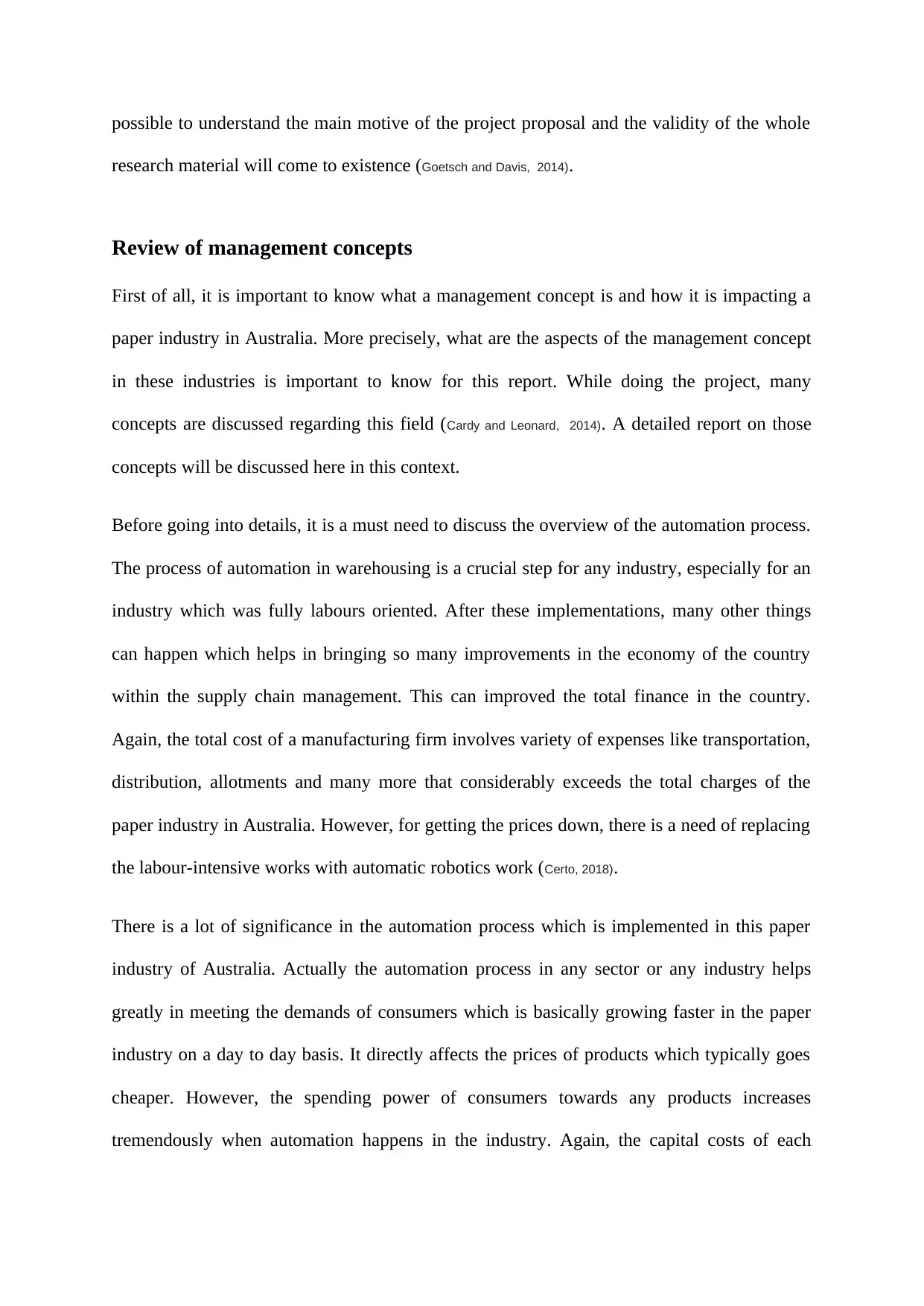
possible to understand the main motive of the project proposal and the validity of the whole
research material will come to existence (Goetsch and Davis, 2014).
Review of management concepts
First of all, it is important to know what a management concept is and how it is impacting a
paper industry in Australia. More precisely, what are the aspects of the management concept
in these industries is important to know for this report. While doing the project, many
concepts are discussed regarding this field (Cardy and Leonard, 2014). A detailed report on those
concepts will be discussed here in this context.
Before going into details, it is a must need to discuss the overview of the automation process.
The process of automation in warehousing is a crucial step for any industry, especially for an
industry which was fully labours oriented. After these implementations, many other things
can happen which helps in bringing so many improvements in the economy of the country
within the supply chain management. This can improved the total finance in the country.
Again, the total cost of a manufacturing firm involves variety of expenses like transportation,
distribution, allotments and many more that considerably exceeds the total charges of the
paper industry in Australia. However, for getting the prices down, there is a need of replacing
the labour-intensive works with automatic robotics work (Certo, 2018).
There is a lot of significance in the automation process which is implemented in this paper
industry of Australia. Actually the automation process in any sector or any industry helps
greatly in meeting the demands of consumers which is basically growing faster in the paper
industry on a day to day basis. It directly affects the prices of products which typically goes
cheaper. However, the spending power of consumers towards any products increases
tremendously when automation happens in the industry. Again, the capital costs of each
research material will come to existence (Goetsch and Davis, 2014).
Review of management concepts
First of all, it is important to know what a management concept is and how it is impacting a
paper industry in Australia. More precisely, what are the aspects of the management concept
in these industries is important to know for this report. While doing the project, many
concepts are discussed regarding this field (Cardy and Leonard, 2014). A detailed report on those
concepts will be discussed here in this context.
Before going into details, it is a must need to discuss the overview of the automation process.
The process of automation in warehousing is a crucial step for any industry, especially for an
industry which was fully labours oriented. After these implementations, many other things
can happen which helps in bringing so many improvements in the economy of the country
within the supply chain management. This can improved the total finance in the country.
Again, the total cost of a manufacturing firm involves variety of expenses like transportation,
distribution, allotments and many more that considerably exceeds the total charges of the
paper industry in Australia. However, for getting the prices down, there is a need of replacing
the labour-intensive works with automatic robotics work (Certo, 2018).
There is a lot of significance in the automation process which is implemented in this paper
industry of Australia. Actually the automation process in any sector or any industry helps
greatly in meeting the demands of consumers which is basically growing faster in the paper
industry on a day to day basis. It directly affects the prices of products which typically goes
cheaper. However, the spending power of consumers towards any products increases
tremendously when automation happens in the industry. Again, the capital costs of each
Paraphrase This Document
Need a fresh take? Get an instant paraphrase of this document with our AI Paraphraser
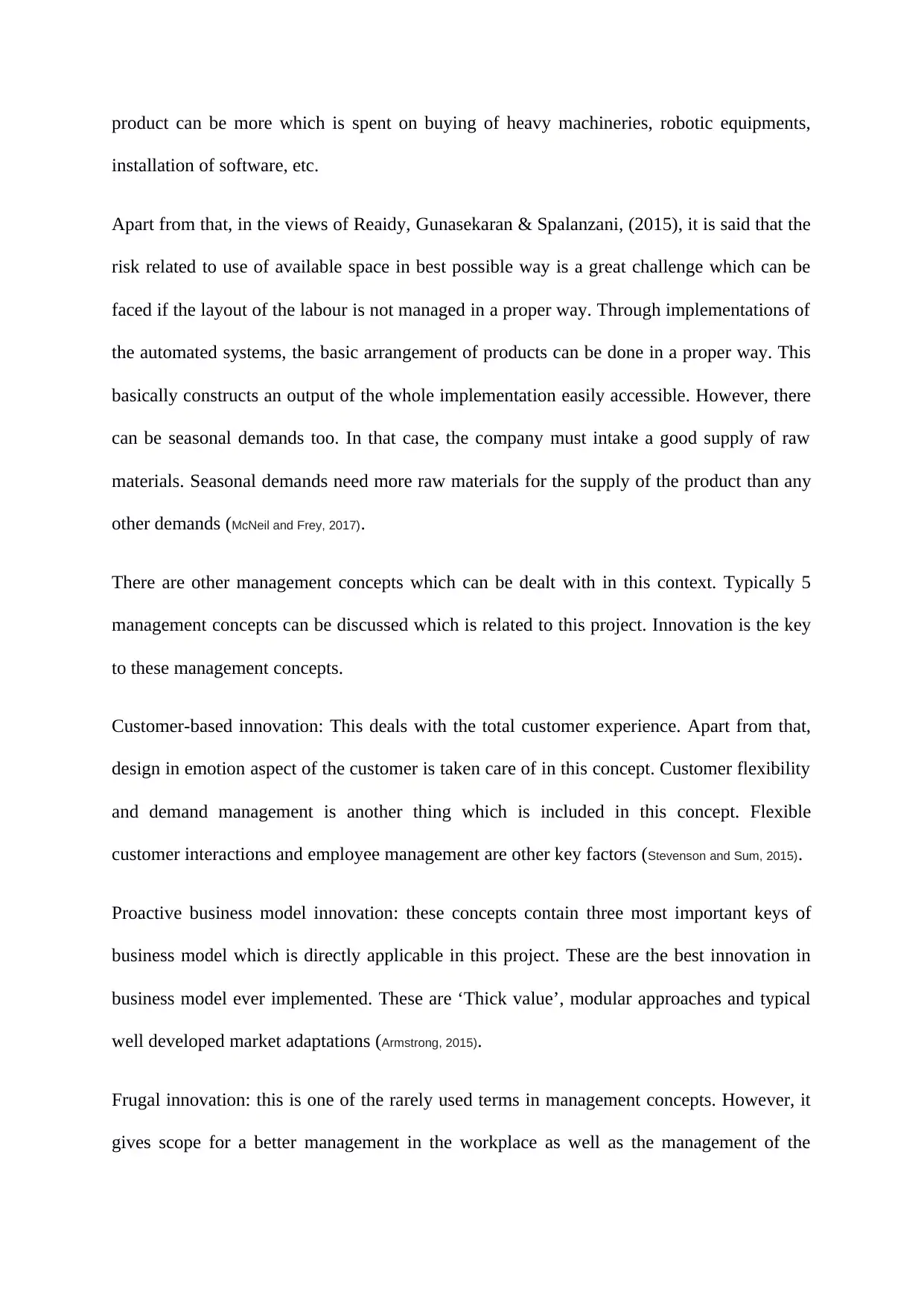
product can be more which is spent on buying of heavy machineries, robotic equipments,
installation of software, etc.
Apart from that, in the views of Reaidy, Gunasekaran & Spalanzani, (2015), it is said that the
risk related to use of available space in best possible way is a great challenge which can be
faced if the layout of the labour is not managed in a proper way. Through implementations of
the automated systems, the basic arrangement of products can be done in a proper way. This
basically constructs an output of the whole implementation easily accessible. However, there
can be seasonal demands too. In that case, the company must intake a good supply of raw
materials. Seasonal demands need more raw materials for the supply of the product than any
other demands (McNeil and Frey, 2017).
There are other management concepts which can be dealt with in this context. Typically 5
management concepts can be discussed which is related to this project. Innovation is the key
to these management concepts.
Customer-based innovation: This deals with the total customer experience. Apart from that,
design in emotion aspect of the customer is taken care of in this concept. Customer flexibility
and demand management is another thing which is included in this concept. Flexible
customer interactions and employee management are other key factors (Stevenson and Sum, 2015).
Proactive business model innovation: these concepts contain three most important keys of
business model which is directly applicable in this project. These are the best innovation in
business model ever implemented. These are ‘Thick value’, modular approaches and typical
well developed market adaptations (Armstrong, 2015).
Frugal innovation: this is one of the rarely used terms in management concepts. However, it
gives scope for a better management in the workplace as well as the management of the
installation of software, etc.
Apart from that, in the views of Reaidy, Gunasekaran & Spalanzani, (2015), it is said that the
risk related to use of available space in best possible way is a great challenge which can be
faced if the layout of the labour is not managed in a proper way. Through implementations of
the automated systems, the basic arrangement of products can be done in a proper way. This
basically constructs an output of the whole implementation easily accessible. However, there
can be seasonal demands too. In that case, the company must intake a good supply of raw
materials. Seasonal demands need more raw materials for the supply of the product than any
other demands (McNeil and Frey, 2017).
There are other management concepts which can be dealt with in this context. Typically 5
management concepts can be discussed which is related to this project. Innovation is the key
to these management concepts.
Customer-based innovation: This deals with the total customer experience. Apart from that,
design in emotion aspect of the customer is taken care of in this concept. Customer flexibility
and demand management is another thing which is included in this concept. Flexible
customer interactions and employee management are other key factors (Stevenson and Sum, 2015).
Proactive business model innovation: these concepts contain three most important keys of
business model which is directly applicable in this project. These are the best innovation in
business model ever implemented. These are ‘Thick value’, modular approaches and typical
well developed market adaptations (Armstrong, 2015).
Frugal innovation: this is one of the rarely used terms in management concepts. However, it
gives scope for a better management in the workplace as well as the management of the
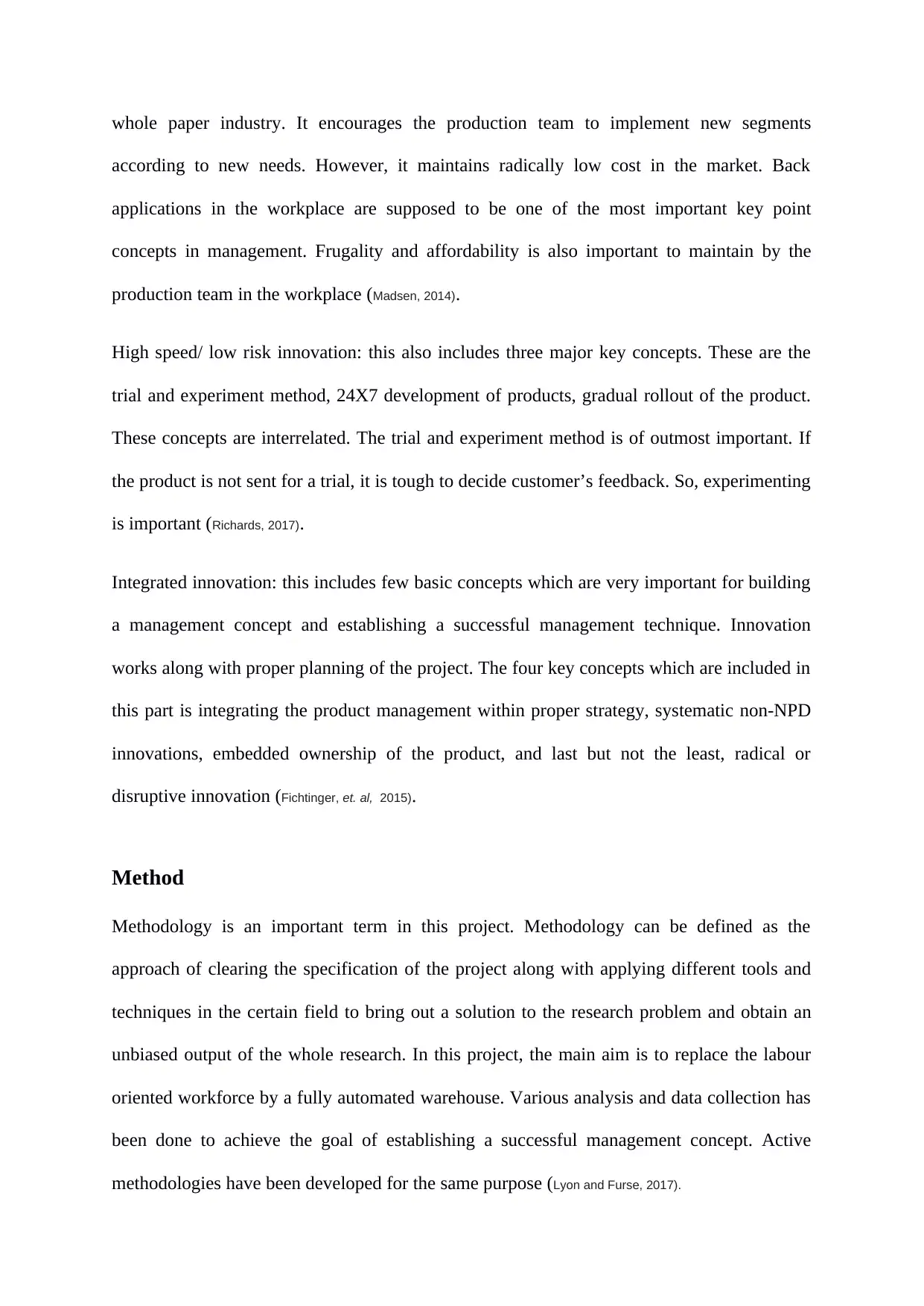
whole paper industry. It encourages the production team to implement new segments
according to new needs. However, it maintains radically low cost in the market. Back
applications in the workplace are supposed to be one of the most important key point
concepts in management. Frugality and affordability is also important to maintain by the
production team in the workplace (Madsen, 2014).
High speed/ low risk innovation: this also includes three major key concepts. These are the
trial and experiment method, 24X7 development of products, gradual rollout of the product.
These concepts are interrelated. The trial and experiment method is of outmost important. If
the product is not sent for a trial, it is tough to decide customer’s feedback. So, experimenting
is important (Richards, 2017).
Integrated innovation: this includes few basic concepts which are very important for building
a management concept and establishing a successful management technique. Innovation
works along with proper planning of the project. The four key concepts which are included in
this part is integrating the product management within proper strategy, systematic non-NPD
innovations, embedded ownership of the product, and last but not the least, radical or
disruptive innovation (Fichtinger, et. al, 2015).
Method
Methodology is an important term in this project. Methodology can be defined as the
approach of clearing the specification of the project along with applying different tools and
techniques in the certain field to bring out a solution to the research problem and obtain an
unbiased output of the whole research. In this project, the main aim is to replace the labour
oriented workforce by a fully automated warehouse. Various analysis and data collection has
been done to achieve the goal of establishing a successful management concept. Active
methodologies have been developed for the same purpose (Lyon and Furse, 2017).
according to new needs. However, it maintains radically low cost in the market. Back
applications in the workplace are supposed to be one of the most important key point
concepts in management. Frugality and affordability is also important to maintain by the
production team in the workplace (Madsen, 2014).
High speed/ low risk innovation: this also includes three major key concepts. These are the
trial and experiment method, 24X7 development of products, gradual rollout of the product.
These concepts are interrelated. The trial and experiment method is of outmost important. If
the product is not sent for a trial, it is tough to decide customer’s feedback. So, experimenting
is important (Richards, 2017).
Integrated innovation: this includes few basic concepts which are very important for building
a management concept and establishing a successful management technique. Innovation
works along with proper planning of the project. The four key concepts which are included in
this part is integrating the product management within proper strategy, systematic non-NPD
innovations, embedded ownership of the product, and last but not the least, radical or
disruptive innovation (Fichtinger, et. al, 2015).
Method
Methodology is an important term in this project. Methodology can be defined as the
approach of clearing the specification of the project along with applying different tools and
techniques in the certain field to bring out a solution to the research problem and obtain an
unbiased output of the whole research. In this project, the main aim is to replace the labour
oriented workforce by a fully automated warehouse. Various analysis and data collection has
been done to achieve the goal of establishing a successful management concept. Active
methodologies have been developed for the same purpose (Lyon and Furse, 2017).
⊘ This is a preview!⊘
Do you want full access?
Subscribe today to unlock all pages.

Trusted by 1+ million students worldwide
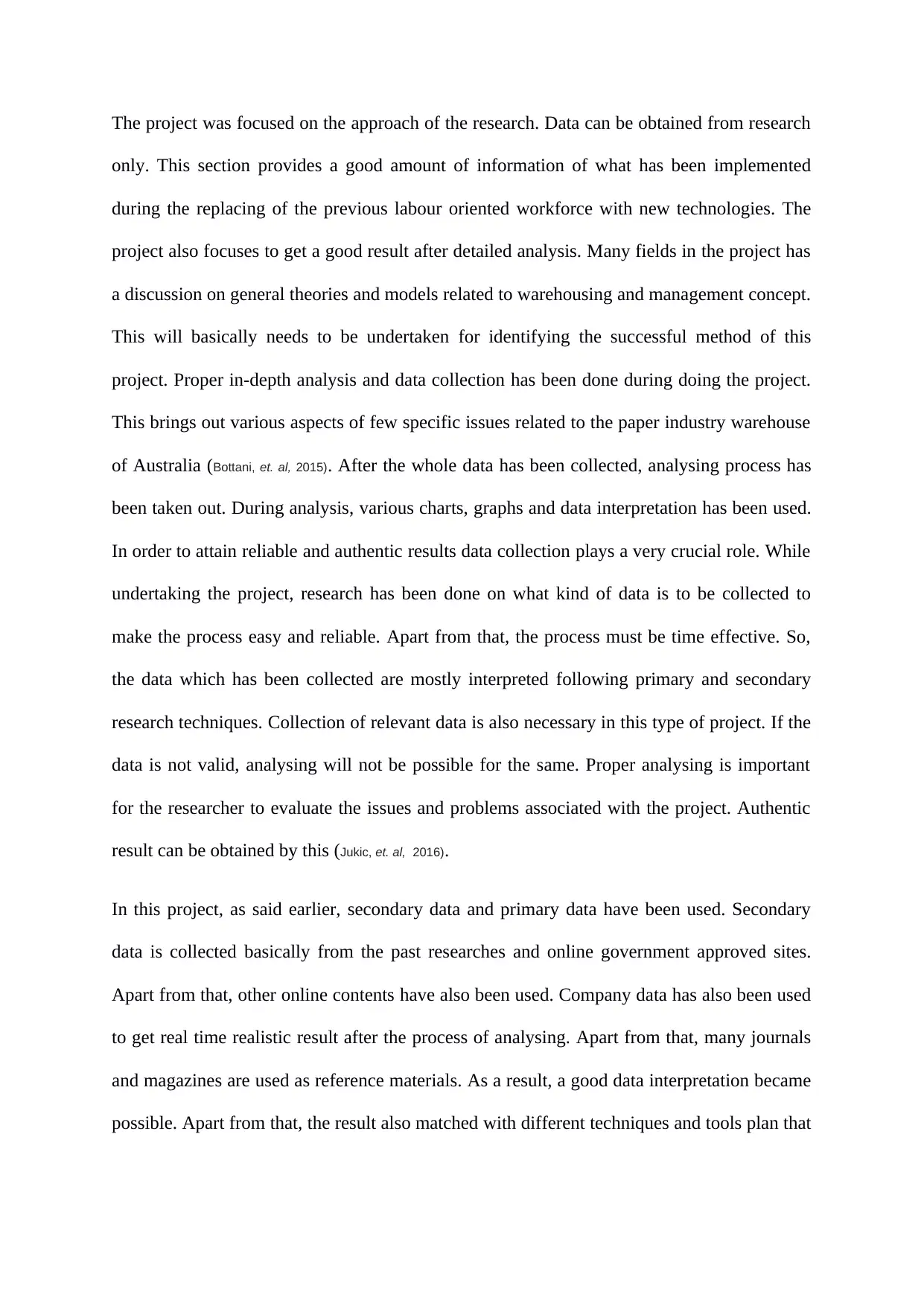
The project was focused on the approach of the research. Data can be obtained from research
only. This section provides a good amount of information of what has been implemented
during the replacing of the previous labour oriented workforce with new technologies. The
project also focuses to get a good result after detailed analysis. Many fields in the project has
a discussion on general theories and models related to warehousing and management concept.
This will basically needs to be undertaken for identifying the successful method of this
project. Proper in-depth analysis and data collection has been done during doing the project.
This brings out various aspects of few specific issues related to the paper industry warehouse
of Australia (Bottani, et. al, 2015). After the whole data has been collected, analysing process has
been taken out. During analysis, various charts, graphs and data interpretation has been used.
In order to attain reliable and authentic results data collection plays a very crucial role. While
undertaking the project, research has been done on what kind of data is to be collected to
make the process easy and reliable. Apart from that, the process must be time effective. So,
the data which has been collected are mostly interpreted following primary and secondary
research techniques. Collection of relevant data is also necessary in this type of project. If the
data is not valid, analysing will not be possible for the same. Proper analysing is important
for the researcher to evaluate the issues and problems associated with the project. Authentic
result can be obtained by this (Jukic, et. al, 2016).
In this project, as said earlier, secondary data and primary data have been used. Secondary
data is collected basically from the past researches and online government approved sites.
Apart from that, other online contents have also been used. Company data has also been used
to get real time realistic result after the process of analysing. Apart from that, many journals
and magazines are used as reference materials. As a result, a good data interpretation became
possible. Apart from that, the result also matched with different techniques and tools plan that
only. This section provides a good amount of information of what has been implemented
during the replacing of the previous labour oriented workforce with new technologies. The
project also focuses to get a good result after detailed analysis. Many fields in the project has
a discussion on general theories and models related to warehousing and management concept.
This will basically needs to be undertaken for identifying the successful method of this
project. Proper in-depth analysis and data collection has been done during doing the project.
This brings out various aspects of few specific issues related to the paper industry warehouse
of Australia (Bottani, et. al, 2015). After the whole data has been collected, analysing process has
been taken out. During analysis, various charts, graphs and data interpretation has been used.
In order to attain reliable and authentic results data collection plays a very crucial role. While
undertaking the project, research has been done on what kind of data is to be collected to
make the process easy and reliable. Apart from that, the process must be time effective. So,
the data which has been collected are mostly interpreted following primary and secondary
research techniques. Collection of relevant data is also necessary in this type of project. If the
data is not valid, analysing will not be possible for the same. Proper analysing is important
for the researcher to evaluate the issues and problems associated with the project. Authentic
result can be obtained by this (Jukic, et. al, 2016).
In this project, as said earlier, secondary data and primary data have been used. Secondary
data is collected basically from the past researches and online government approved sites.
Apart from that, other online contents have also been used. Company data has also been used
to get real time realistic result after the process of analysing. Apart from that, many journals
and magazines are used as reference materials. As a result, a good data interpretation became
possible. Apart from that, the result also matched with different techniques and tools plan that
Paraphrase This Document
Need a fresh take? Get an instant paraphrase of this document with our AI Paraphraser
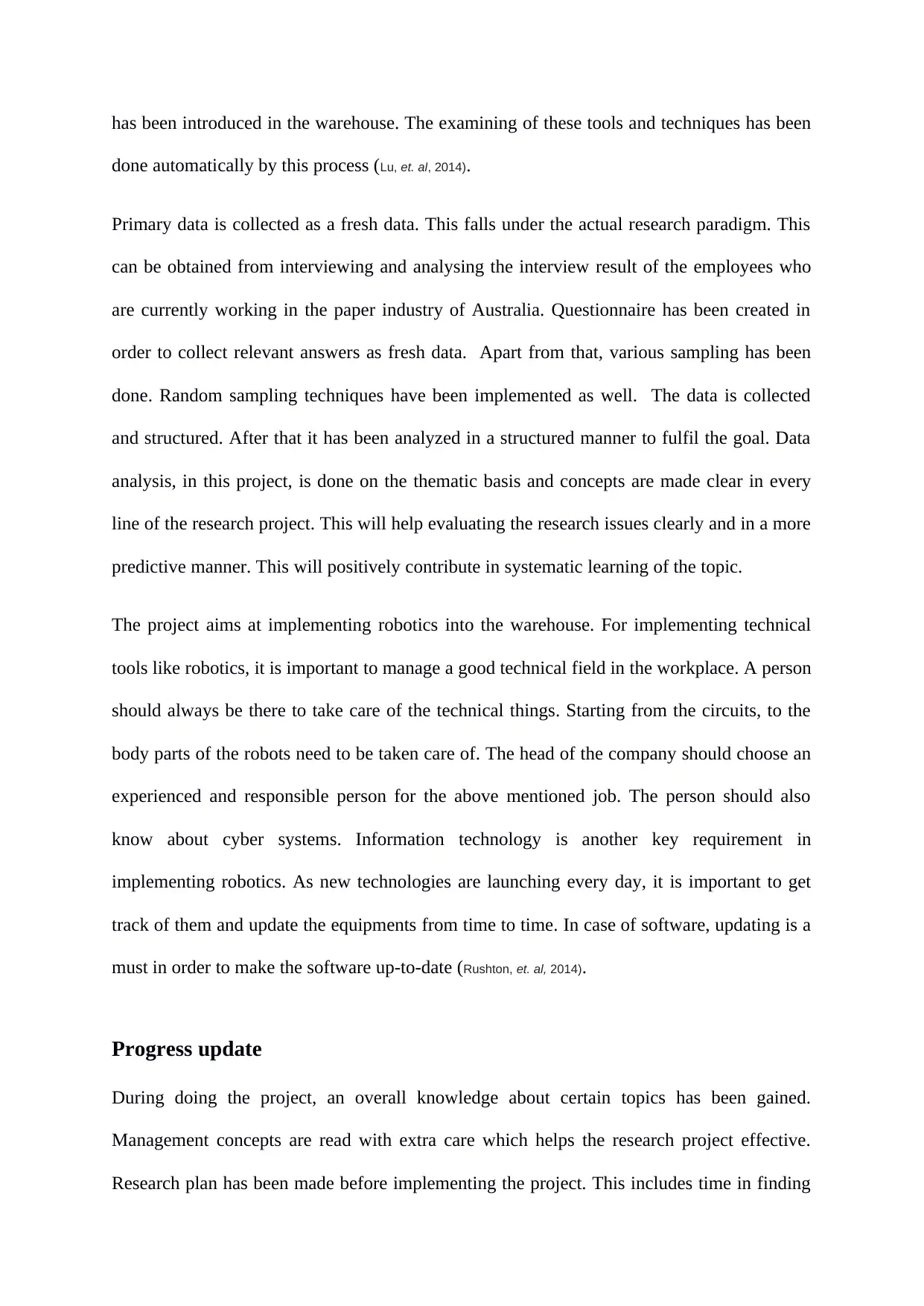
has been introduced in the warehouse. The examining of these tools and techniques has been
done automatically by this process (Lu, et. al, 2014).
Primary data is collected as a fresh data. This falls under the actual research paradigm. This
can be obtained from interviewing and analysing the interview result of the employees who
are currently working in the paper industry of Australia. Questionnaire has been created in
order to collect relevant answers as fresh data. Apart from that, various sampling has been
done. Random sampling techniques have been implemented as well. The data is collected
and structured. After that it has been analyzed in a structured manner to fulfil the goal. Data
analysis, in this project, is done on the thematic basis and concepts are made clear in every
line of the research project. This will help evaluating the research issues clearly and in a more
predictive manner. This will positively contribute in systematic learning of the topic.
The project aims at implementing robotics into the warehouse. For implementing technical
tools like robotics, it is important to manage a good technical field in the workplace. A person
should always be there to take care of the technical things. Starting from the circuits, to the
body parts of the robots need to be taken care of. The head of the company should choose an
experienced and responsible person for the above mentioned job. The person should also
know about cyber systems. Information technology is another key requirement in
implementing robotics. As new technologies are launching every day, it is important to get
track of them and update the equipments from time to time. In case of software, updating is a
must in order to make the software up-to-date (Rushton, et. al, 2014).
Progress update
During doing the project, an overall knowledge about certain topics has been gained.
Management concepts are read with extra care which helps the research project effective.
Research plan has been made before implementing the project. This includes time in finding
done automatically by this process (Lu, et. al, 2014).
Primary data is collected as a fresh data. This falls under the actual research paradigm. This
can be obtained from interviewing and analysing the interview result of the employees who
are currently working in the paper industry of Australia. Questionnaire has been created in
order to collect relevant answers as fresh data. Apart from that, various sampling has been
done. Random sampling techniques have been implemented as well. The data is collected
and structured. After that it has been analyzed in a structured manner to fulfil the goal. Data
analysis, in this project, is done on the thematic basis and concepts are made clear in every
line of the research project. This will help evaluating the research issues clearly and in a more
predictive manner. This will positively contribute in systematic learning of the topic.
The project aims at implementing robotics into the warehouse. For implementing technical
tools like robotics, it is important to manage a good technical field in the workplace. A person
should always be there to take care of the technical things. Starting from the circuits, to the
body parts of the robots need to be taken care of. The head of the company should choose an
experienced and responsible person for the above mentioned job. The person should also
know about cyber systems. Information technology is another key requirement in
implementing robotics. As new technologies are launching every day, it is important to get
track of them and update the equipments from time to time. In case of software, updating is a
must in order to make the software up-to-date (Rushton, et. al, 2014).
Progress update
During doing the project, an overall knowledge about certain topics has been gained.
Management concepts are read with extra care which helps the research project effective.
Research plan has been made before implementing the project. This includes time in finding
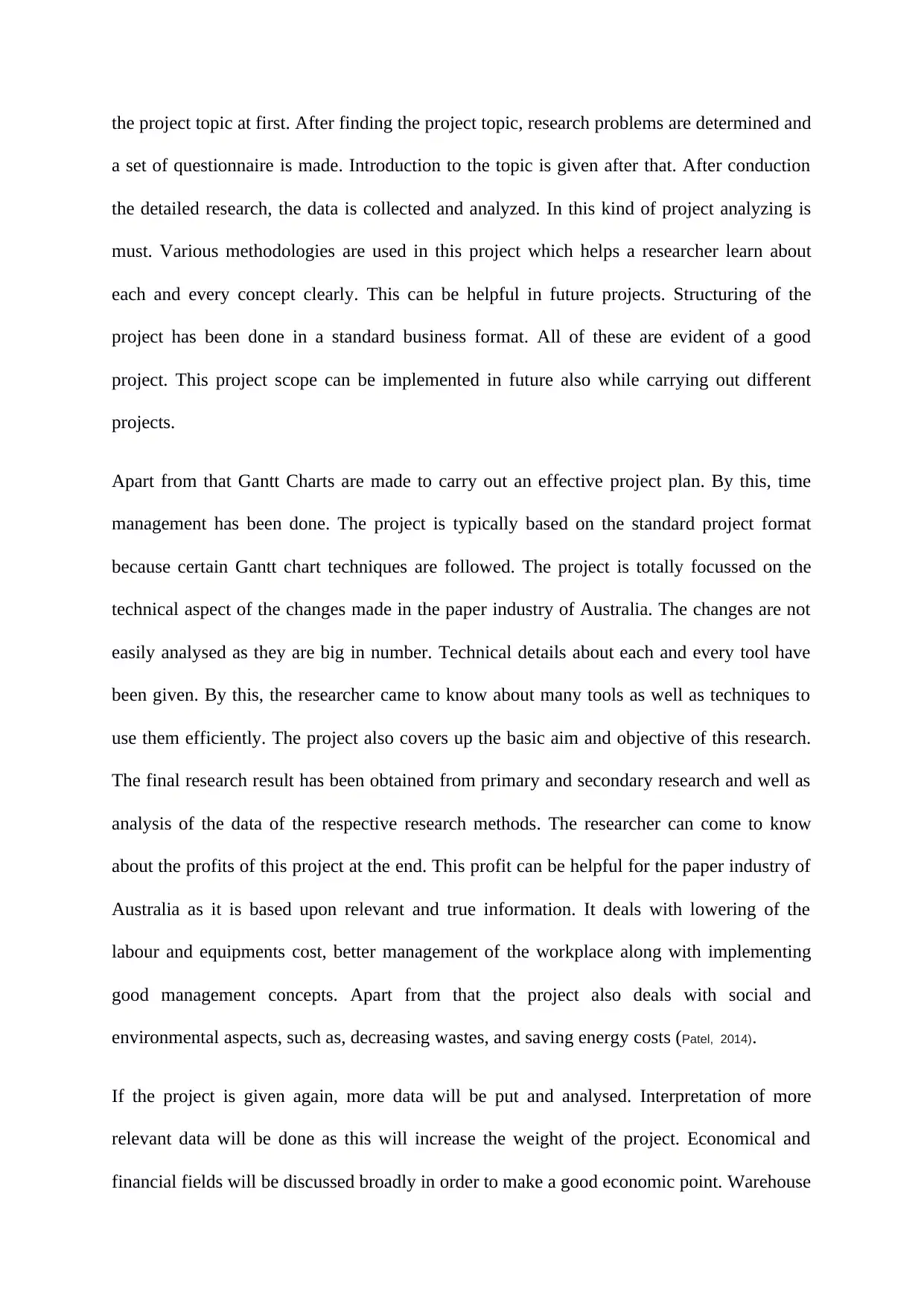
the project topic at first. After finding the project topic, research problems are determined and
a set of questionnaire is made. Introduction to the topic is given after that. After conduction
the detailed research, the data is collected and analyzed. In this kind of project analyzing is
must. Various methodologies are used in this project which helps a researcher learn about
each and every concept clearly. This can be helpful in future projects. Structuring of the
project has been done in a standard business format. All of these are evident of a good
project. This project scope can be implemented in future also while carrying out different
projects.
Apart from that Gantt Charts are made to carry out an effective project plan. By this, time
management has been done. The project is typically based on the standard project format
because certain Gantt chart techniques are followed. The project is totally focussed on the
technical aspect of the changes made in the paper industry of Australia. The changes are not
easily analysed as they are big in number. Technical details about each and every tool have
been given. By this, the researcher came to know about many tools as well as techniques to
use them efficiently. The project also covers up the basic aim and objective of this research.
The final research result has been obtained from primary and secondary research and well as
analysis of the data of the respective research methods. The researcher can come to know
about the profits of this project at the end. This profit can be helpful for the paper industry of
Australia as it is based upon relevant and true information. It deals with lowering of the
labour and equipments cost, better management of the workplace along with implementing
good management concepts. Apart from that the project also deals with social and
environmental aspects, such as, decreasing wastes, and saving energy costs (Patel, 2014).
If the project is given again, more data will be put and analysed. Interpretation of more
relevant data will be done as this will increase the weight of the project. Economical and
financial fields will be discussed broadly in order to make a good economic point. Warehouse
a set of questionnaire is made. Introduction to the topic is given after that. After conduction
the detailed research, the data is collected and analyzed. In this kind of project analyzing is
must. Various methodologies are used in this project which helps a researcher learn about
each and every concept clearly. This can be helpful in future projects. Structuring of the
project has been done in a standard business format. All of these are evident of a good
project. This project scope can be implemented in future also while carrying out different
projects.
Apart from that Gantt Charts are made to carry out an effective project plan. By this, time
management has been done. The project is typically based on the standard project format
because certain Gantt chart techniques are followed. The project is totally focussed on the
technical aspect of the changes made in the paper industry of Australia. The changes are not
easily analysed as they are big in number. Technical details about each and every tool have
been given. By this, the researcher came to know about many tools as well as techniques to
use them efficiently. The project also covers up the basic aim and objective of this research.
The final research result has been obtained from primary and secondary research and well as
analysis of the data of the respective research methods. The researcher can come to know
about the profits of this project at the end. This profit can be helpful for the paper industry of
Australia as it is based upon relevant and true information. It deals with lowering of the
labour and equipments cost, better management of the workplace along with implementing
good management concepts. Apart from that the project also deals with social and
environmental aspects, such as, decreasing wastes, and saving energy costs (Patel, 2014).
If the project is given again, more data will be put and analysed. Interpretation of more
relevant data will be done as this will increase the weight of the project. Economical and
financial fields will be discussed broadly in order to make a good economic point. Warehouse
⊘ This is a preview!⊘
Do you want full access?
Subscribe today to unlock all pages.

Trusted by 1+ million students worldwide
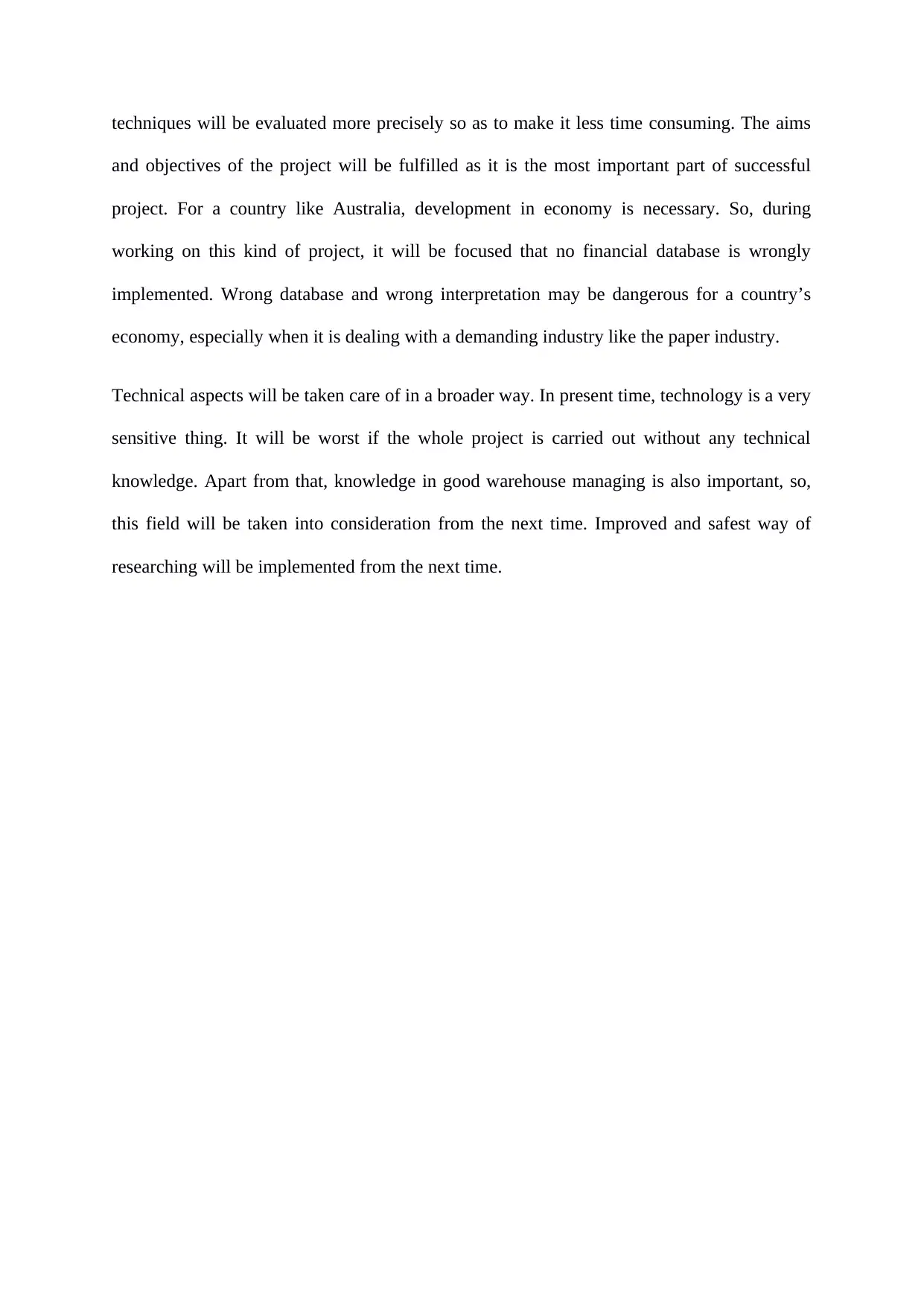
techniques will be evaluated more precisely so as to make it less time consuming. The aims
and objectives of the project will be fulfilled as it is the most important part of successful
project. For a country like Australia, development in economy is necessary. So, during
working on this kind of project, it will be focused that no financial database is wrongly
implemented. Wrong database and wrong interpretation may be dangerous for a country’s
economy, especially when it is dealing with a demanding industry like the paper industry.
Technical aspects will be taken care of in a broader way. In present time, technology is a very
sensitive thing. It will be worst if the whole project is carried out without any technical
knowledge. Apart from that, knowledge in good warehouse managing is also important, so,
this field will be taken into consideration from the next time. Improved and safest way of
researching will be implemented from the next time.
and objectives of the project will be fulfilled as it is the most important part of successful
project. For a country like Australia, development in economy is necessary. So, during
working on this kind of project, it will be focused that no financial database is wrongly
implemented. Wrong database and wrong interpretation may be dangerous for a country’s
economy, especially when it is dealing with a demanding industry like the paper industry.
Technical aspects will be taken care of in a broader way. In present time, technology is a very
sensitive thing. It will be worst if the whole project is carried out without any technical
knowledge. Apart from that, knowledge in good warehouse managing is also important, so,
this field will be taken into consideration from the next time. Improved and safest way of
researching will be implemented from the next time.
Paraphrase This Document
Need a fresh take? Get an instant paraphrase of this document with our AI Paraphraser
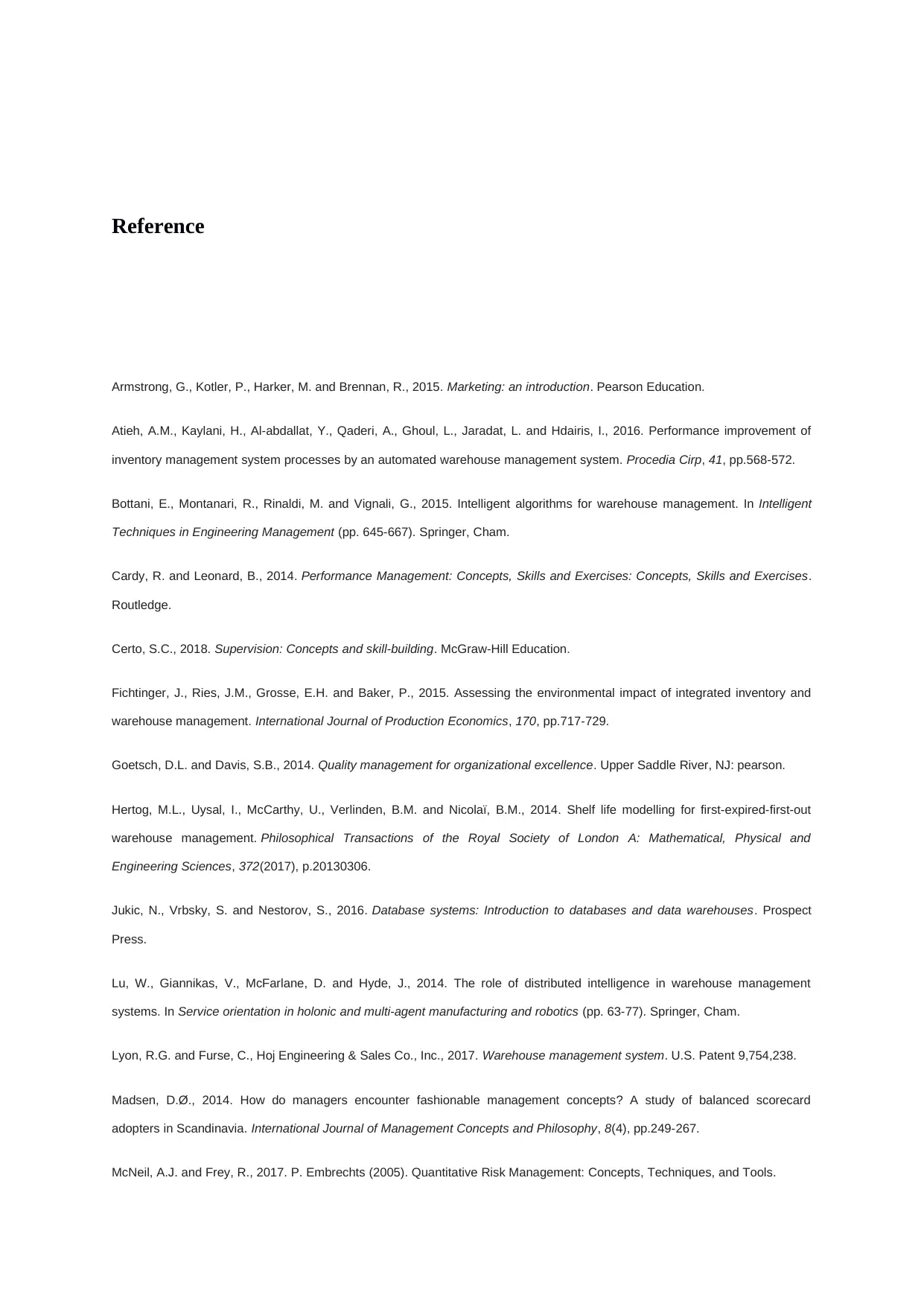
Reference
Armstrong, G., Kotler, P., Harker, M. and Brennan, R., 2015. Marketing: an introduction. Pearson Education.
Atieh, A.M., Kaylani, H., Al-abdallat, Y., Qaderi, A., Ghoul, L., Jaradat, L. and Hdairis, I., 2016. Performance improvement of
inventory management system processes by an automated warehouse management system. Procedia Cirp, 41, pp.568-572.
Bottani, E., Montanari, R., Rinaldi, M. and Vignali, G., 2015. Intelligent algorithms for warehouse management. In Intelligent
Techniques in Engineering Management (pp. 645-667). Springer, Cham.
Cardy, R. and Leonard, B., 2014. Performance Management: Concepts, Skills and Exercises: Concepts, Skills and Exercises.
Routledge.
Certo, S.C., 2018. Supervision: Concepts and skill-building. McGraw-Hill Education.
Fichtinger, J., Ries, J.M., Grosse, E.H. and Baker, P., 2015. Assessing the environmental impact of integrated inventory and
warehouse management. International Journal of Production Economics, 170, pp.717-729.
Goetsch, D.L. and Davis, S.B., 2014. Quality management for organizational excellence. Upper Saddle River, NJ: pearson.
Hertog, M.L., Uysal, I., McCarthy, U., Verlinden, B.M. and Nicolaï, B.M., 2014. Shelf life modelling for first-expired-first-out
warehouse management. Philosophical Transactions of the Royal Society of London A: Mathematical, Physical and
Engineering Sciences, 372(2017), p.20130306.
Jukic, N., Vrbsky, S. and Nestorov, S., 2016. Database systems: Introduction to databases and data warehouses. Prospect
Press.
Lu, W., Giannikas, V., McFarlane, D. and Hyde, J., 2014. The role of distributed intelligence in warehouse management
systems. In Service orientation in holonic and multi-agent manufacturing and robotics (pp. 63-77). Springer, Cham.
Lyon, R.G. and Furse, C., Hoj Engineering & Sales Co., Inc., 2017. Warehouse management system. U.S. Patent 9,754,238.
Madsen, D.Ø., 2014. How do managers encounter fashionable management concepts? A study of balanced scorecard
adopters in Scandinavia. International Journal of Management Concepts and Philosophy, 8(4), pp.249-267.
McNeil, A.J. and Frey, R., 2017. P. Embrechts (2005). Quantitative Risk Management: Concepts, Techniques, and Tools.
Armstrong, G., Kotler, P., Harker, M. and Brennan, R., 2015. Marketing: an introduction. Pearson Education.
Atieh, A.M., Kaylani, H., Al-abdallat, Y., Qaderi, A., Ghoul, L., Jaradat, L. and Hdairis, I., 2016. Performance improvement of
inventory management system processes by an automated warehouse management system. Procedia Cirp, 41, pp.568-572.
Bottani, E., Montanari, R., Rinaldi, M. and Vignali, G., 2015. Intelligent algorithms for warehouse management. In Intelligent
Techniques in Engineering Management (pp. 645-667). Springer, Cham.
Cardy, R. and Leonard, B., 2014. Performance Management: Concepts, Skills and Exercises: Concepts, Skills and Exercises.
Routledge.
Certo, S.C., 2018. Supervision: Concepts and skill-building. McGraw-Hill Education.
Fichtinger, J., Ries, J.M., Grosse, E.H. and Baker, P., 2015. Assessing the environmental impact of integrated inventory and
warehouse management. International Journal of Production Economics, 170, pp.717-729.
Goetsch, D.L. and Davis, S.B., 2014. Quality management for organizational excellence. Upper Saddle River, NJ: pearson.
Hertog, M.L., Uysal, I., McCarthy, U., Verlinden, B.M. and Nicolaï, B.M., 2014. Shelf life modelling for first-expired-first-out
warehouse management. Philosophical Transactions of the Royal Society of London A: Mathematical, Physical and
Engineering Sciences, 372(2017), p.20130306.
Jukic, N., Vrbsky, S. and Nestorov, S., 2016. Database systems: Introduction to databases and data warehouses. Prospect
Press.
Lu, W., Giannikas, V., McFarlane, D. and Hyde, J., 2014. The role of distributed intelligence in warehouse management
systems. In Service orientation in holonic and multi-agent manufacturing and robotics (pp. 63-77). Springer, Cham.
Lyon, R.G. and Furse, C., Hoj Engineering & Sales Co., Inc., 2017. Warehouse management system. U.S. Patent 9,754,238.
Madsen, D.Ø., 2014. How do managers encounter fashionable management concepts? A study of balanced scorecard
adopters in Scandinavia. International Journal of Management Concepts and Philosophy, 8(4), pp.249-267.
McNeil, A.J. and Frey, R., 2017. P. Embrechts (2005). Quantitative Risk Management: Concepts, Techniques, and Tools.
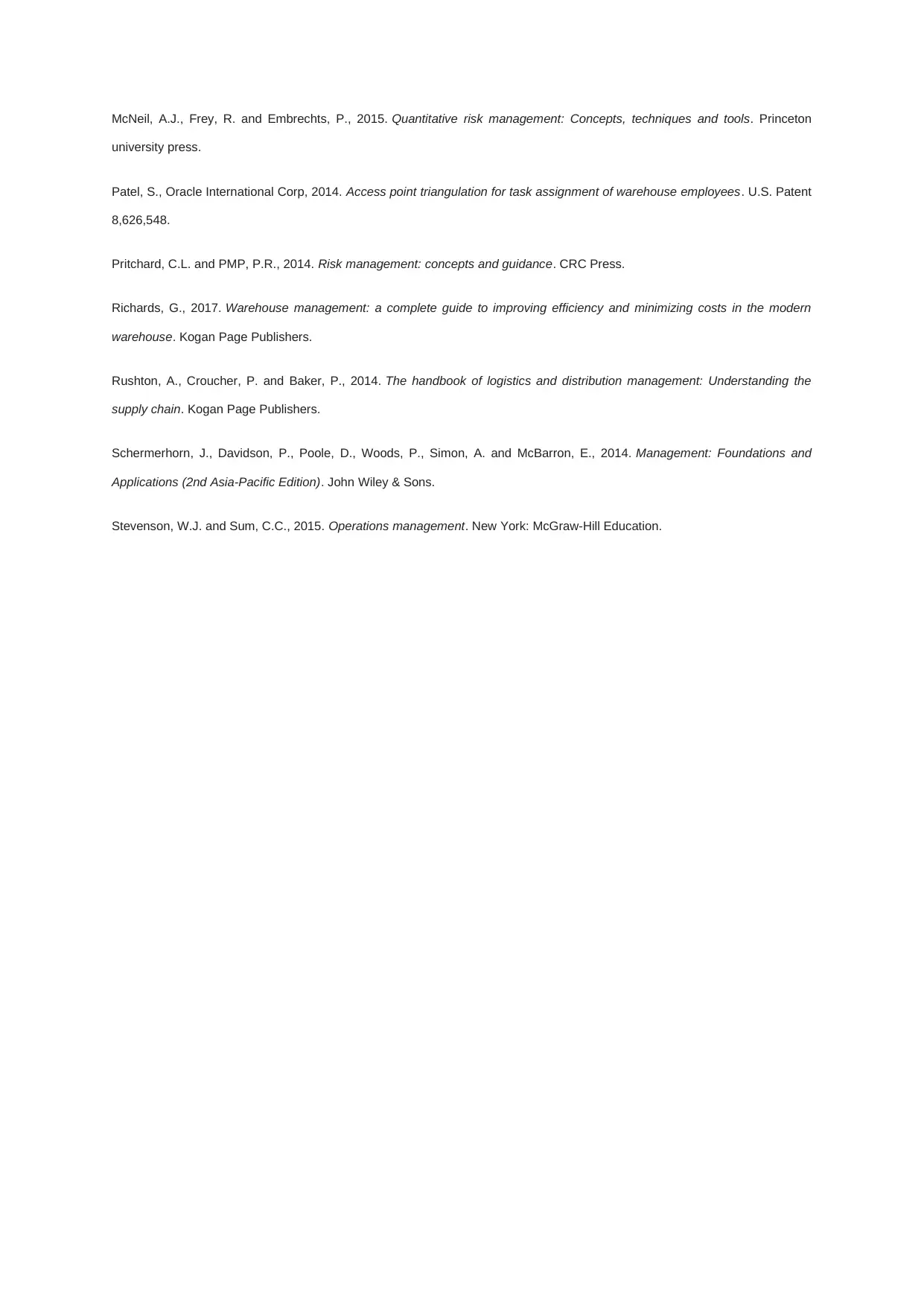
McNeil, A.J., Frey, R. and Embrechts, P., 2015. Quantitative risk management: Concepts, techniques and tools. Princeton
university press.
Patel, S., Oracle International Corp, 2014. Access point triangulation for task assignment of warehouse employees. U.S. Patent
8,626,548.
Pritchard, C.L. and PMP, P.R., 2014. Risk management: concepts and guidance. CRC Press.
Richards, G., 2017. Warehouse management: a complete guide to improving efficiency and minimizing costs in the modern
warehouse. Kogan Page Publishers.
Rushton, A., Croucher, P. and Baker, P., 2014. The handbook of logistics and distribution management: Understanding the
supply chain. Kogan Page Publishers.
Schermerhorn, J., Davidson, P., Poole, D., Woods, P., Simon, A. and McBarron, E., 2014. Management: Foundations and
Applications (2nd Asia-Pacific Edition). John Wiley & Sons.
Stevenson, W.J. and Sum, C.C., 2015. Operations management. New York: McGraw-Hill Education.
university press.
Patel, S., Oracle International Corp, 2014. Access point triangulation for task assignment of warehouse employees. U.S. Patent
8,626,548.
Pritchard, C.L. and PMP, P.R., 2014. Risk management: concepts and guidance. CRC Press.
Richards, G., 2017. Warehouse management: a complete guide to improving efficiency and minimizing costs in the modern
warehouse. Kogan Page Publishers.
Rushton, A., Croucher, P. and Baker, P., 2014. The handbook of logistics and distribution management: Understanding the
supply chain. Kogan Page Publishers.
Schermerhorn, J., Davidson, P., Poole, D., Woods, P., Simon, A. and McBarron, E., 2014. Management: Foundations and
Applications (2nd Asia-Pacific Edition). John Wiley & Sons.
Stevenson, W.J. and Sum, C.C., 2015. Operations management. New York: McGraw-Hill Education.
⊘ This is a preview!⊘
Do you want full access?
Subscribe today to unlock all pages.

Trusted by 1+ million students worldwide
1 out of 12
Related Documents
Your All-in-One AI-Powered Toolkit for Academic Success.
+13062052269
info@desklib.com
Available 24*7 on WhatsApp / Email
![[object Object]](/_next/static/media/star-bottom.7253800d.svg)
Unlock your academic potential
Copyright © 2020–2025 A2Z Services. All Rights Reserved. Developed and managed by ZUCOL.



